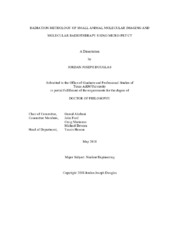| dc.description.abstract | Genetically engineered animal models of diseases are increasingly recapitulating human diseases. With this, in vivo preclinical imaging of small laboratory animals has emerged as a critical component of biomedical research because of its noninvasive nature allowing serial assay of animal models and monitoring its safety and effectiveness over the history of the disease. The concept of quantitative molecular imaging is to go beyond displaying images in digital form and to consider the image and extract quantitative information that allows for a better understanding of disease progression and treatment. The aim of this work is to demonstrate the need for the metrology of molecular imaging of animal models using micro-PET/CT devices.
System characteristics are determined within each subsystem, micro-PET and micro-CT, independent of each other, and as integrated systems. The characterization of tissues, composition and density, by micro-CT was determined along with the noise level of the unit. Moreover, the nominal superficial and deep absorbed doses were estimated to assess the confounding effect of multiple scans in animal studies. The Q value, used to convert counts per milliliter to activity per milliliter, was estimated to assess the observed activity present in the animal. The resolution of the micro-PET subsystem was also estimated using a modified Derenzo phantom to assess the uncertainty of the activity distribution within tissues. Once both modalities were characterized separately the coordinate system of each individual system was checked for spatial accuracy using a cross capillary method. The offset values were then used to establish the same coordinate system for co-registration.
Once both micro-PET and micro-CT image data sets had been verified, they were used to generate a voxel image of the subject for use in the Monte Carlo program, MCNP6, where an absorbed dose map was generated for the radiolabeled compound. Two basic examples are given to demonstrate the use of the voxelized absorbed dose maps for calculating the absorbed dose to any segmented organ of interest, across longitudinal studies. In this way, it was shown that an animal-specific model can be used to accurately calculate the absorbed dose for each time point during a study. | en |


